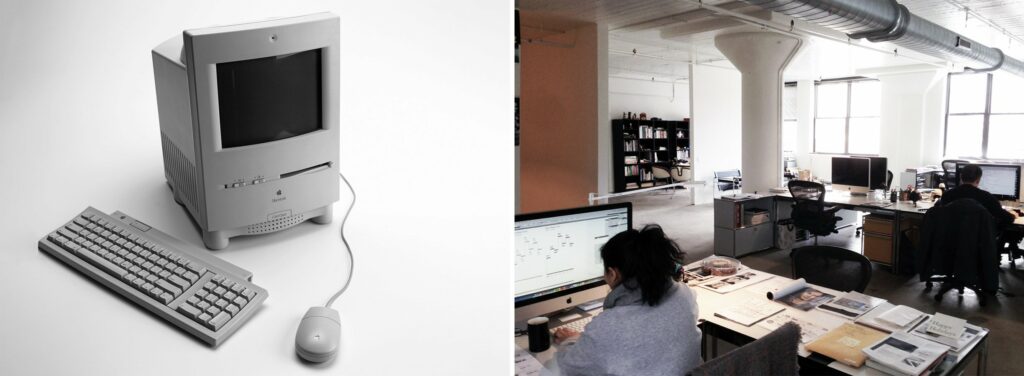Having come of age at the time when the computer was introduced and subsequently embraced as a radically new design tool, I and others of my generation have seen it profoundly affect every aspect of design. The definition of where graphic design begins and ends is becoming blurred as technology supersedes craftsmanship. Designers who learn to navigate along this divide will ultimately be the most successful. The interrelationships between print, digital, film, and art ensures that graphic design will remain a vital part of the future.
In the past, graphic design has been considered a sidekick to literature, art, film, music and even advertising – sometimes appreciated but typically overlooked. At times debated, but only within the design community. Over the past decade or so, there is a growing opinion that design is an end to itself. Perhaps this idea is sprung through the emergence of a generation of do-it-youself website developers who have a basic knowledge of software applications, type fonts, and image effects, but lack the training of professional designers.
We live in the age of technology where digital ‘solutions’ designed to act a substitute for craft are posted on-line to draw thousands of customers who are willing to pay a monthly fee for services. This empowers amateurs and marginalizes professionals – why pay a professional when there’s a do-it-yourself solution that can be subscribed to for a small monthly fee? Designers are being replaced by brand strategists, data engineers and marketing specialists. Even worse, by software applications and on-line “How To” blog posts.
Design aptitude, creativity, and creative thinking are being challenged by Artificial Intelligence (AI) with the goal that in future generations, human reason, instinct and creativity can be replaced by a smarter program. The outcome, I’m afraid, will be less human, less joyful and less original. Technology is encroaching on fine art, as well. Today, you can use a digital program to take digital readings from paintings and create similar types of “paintings” in endless combinations. But these images have no soul.
In the name of progress, we have sacrificed our inherent need for craftsmanship and art. The technology era that started in the early 1980’s transformed the way designers work and how they are perceived. The playing field between the professional designer and an aspiring one was leveled, to some degree by the computer. This was good for the aspiring designer whose talent and skills were limited, and bad for the professional designer who had significant knowledge and had mastered his/her craft. Whether or not to adopt the computer was at the top of every designer’s mind, challenging the way they worked. In a roundtable discussion centered on design and the computer, designer and artist, Milton Glaser, famously said “The typewriter never improved the quality of poetry”. At first, most designers saw the computer as no match for their skill and finesse, but within a few years, it would be hard to find a design studio that didn’t have one. Almost overnight, it seemed, design experienced a shift that has only been amplified over time.

Apple Macintosh Computer 1984 / Grady Campbell Studio, Chicago Illinois
In today’s technology world, the design studio, which for generations was led by a designer who had the talent and skill to make a name for themselves, has been replaced with slick, packaged “solutions” companies with packaged services that are sold by creative service managers who know how to sell, but lack the talent and commitment for quality design. For the most part, the fine art of graphic design is lost, and with that, the designer’s role has been marginalized. On the flip side, technology has emboldened tech savvy designers to be more experimental and more efficient, with the ability to impact more people than ever before.
For every competent designer there is a host of competent programmers whose numbers are growing at mindblowing speed. Of course, the computer can produce visual effects not possible by other means. Inarguably, the virtues of the computer for the designer is the abundance of graphic possibilities, and the speed and versatility of applications. In the hands of a thoughtful designer, this is quite useful. Computers may even help in the creative process by suggesting visual possibilities unimaginable with other techniques or by helping to solve problems specifically designed for the computers’ capabilities. But the same virtue or potential is easily exploited for the sake of effect by designers who may or may not have learned the difference between an effect and good design. The baffling complexity of much computer-generated design today is a testament to the learning gap. When to use computers is certainly as important as how to use them.
From my experience, technology drives design innovation. New technologies are often embraced prematurely at the expense of good design, but eventually, as the technology improves, good design follows. Graphic designers are caught in the technology stream that is wide and fast, but not very deep. The only way to navigate within it is to go faster or slower
than the stream. To go faster, we need to ride the wave of technology and fashion that is continuously changing at an unprecedented rate. To go slower, you need to understand context through history and theory. Designers are predisposed to go faster or slower, depending on their inclination or experi- ence, but most are being swept away in the currents of tech- pop mediocrity.
Technology started to have a lasting impact on design at the same time that I started my design career. Soon after I started working at Container Corporation of America, I learned that what we designed was produced by a small boutique Chicago printer owned and operated by a Swiss craftsman named Rudy Rohner. When competing print salesmen learned that there was a new designer on-board, they seized the oppor- tunity to break through our Rohner relationship by calling me. The salesman who managed to get my attention represented a new, well-financed print company with a massive state-of- the-art facility, a fleet of six-color Heidelberg presses and all of the latest pre-press technology. The salesman drove a Ferrari and wore tailored Italian suits of the finest quality. He asked for an appointment, and I gave it to him. When we met, he presented his company’s capabilities, world-class facility and around-the-clock support services. He was most excited to share his company’s patented tri-tone, 300-line printing process. I had never heard of such a thing and at first glance, the samples were impressive.
I asked the director of our department, John Massey, for his opinion in regard to this new company and their high-tech printing processes. He suggested that I call Rudy to have him take a look, so I did. Rudy insisted that he meet with me in person and bring along some of his samples for comparison. He showed up disheveled with the rolled samples under his arm. He asked me to lay his samples flat, side by side, next to the competitor’s. Rudy’s samples were printed on old four-color Miele presses using a traditional 175-line resolution duotone technique. He asked, “So, which do you like better?” Without question, his was better. When I shared the experience with John, he smiled and said he wasn’t surprised. The lessons learned were that human’s have value, craft often trumps technology, and that having more, spending more, does not mean the result is better.
